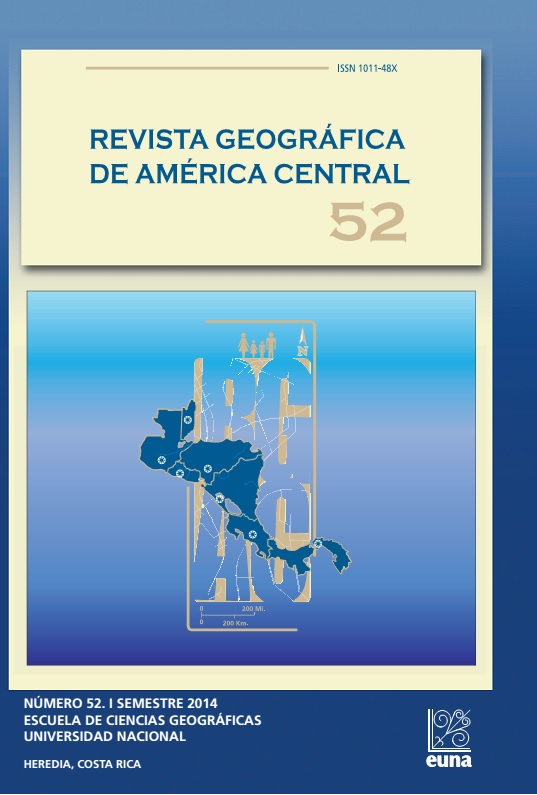EL CIBERESPACIO Y LAS POSIBILIDADES DE VISUALIZACIÓN DE (AL MENOS) CUATRO TIPOS DE LA ESPACIALIDAD
Palabras clave:
Espacio, espacialidad, visualización, Sistemas de Información GeográficaResumen
Las posibilidades de visualización de los tipos del espacio, concebido de una manera específica (se aplica el término «la espacialidad»), crecen con el uso de las tecnologías informáticas y comunicativas. Han sido elegidos cuatro tipos de la espacialidad según la teoría de Hynek y Vávra (2007) y en consecuencia, sometidos bajo una examinación detallada. Las espacialidades natural y socioeconómica pueden ser visualizadas fácilmente con los Sistemas de Información Geográfica (SIG) utilizando la modelación 3D. Este texto estudia los ejemplos de la visualización en cada de las espacialidades, discute el potencial y los riesgos de los utensilios usados para la visualización en los ordenadores y propone una implementación adecuada en Geografía y una posible transición entre las espacialidades definidas.
Referencias
Aaltonen, A., Lehikoinen, J. (2006). Exploring augmented reality visualizations. In AVI ‚06 Proceedings of the working conference on Advanced visual interfaces. New York : ACM. p. 453 – 456. ISBN 1-59593-353-0
Abler, A. H. (2001). Geography: history and concepts. 3rd edition. Los Angeles: Sage.
Harvey, D. (1973). Social Justice and the City. Baltimore: Johns Hopkins University Press. Cloke, P. et al. (2005). Introducing human geographies. 2nd ed. London: Hodder Arnold.
GE Ecomagination. Ecomagination [online]. [cit. 6. 6. 2013]. Accesible en: http://ge.ecomagination.com/smartgrid/#/augmented_reality
Hynek, A. (2007). Humánní geografie ve studiu krajiny. In: Herber, V. (ed.): Fyzickogeografický sborník 4: Fyzická geografie teorie a aplikace. Brno: Masarykova universita. s. 7–13.
Hynek, A. & Vávra, J. (2007). (Přinejmenším) čtyři prostorovosti krajiny. In: Fyzickogeografický sborník 5 z 24. výroční konference fyzickogeografické sekce České geografické společnosti 13. a 14.února 2007 v Brně. Fyzická geografie- výzkum, vzdělávání, aplikace , ed.V.Herber, MU Brno, 2007, s. 7-14
Hynek, A. (2009a). Prostorovosti: místa, krajiny, regiony. Acta Geographica Universitatis Comenianae, 53, s. 79-90. Univerzita Komenského v Bratislave.
Hynek, A. (2009b). Studium kulturní krajiny. In. Herber, V. (ed.): Fyzická geografie a krajinná ekologie : příspěvky z 26. výroční konference Fyzickogeografické sekce České geografické společnosti konané 10. a 11. února 2009 v Brně. Brno: Masarykova univerzita, s. 16-23.
Hynek, A. (2009c). The Politics of Landscape on Regional and Local Levels. GeoScape. (4) 1, s. 10-27.
Kainz, W. (2008). Theory and Practice of Fuzzy Sets in GIS. In: Schiewe J., Michel U. (eds.), Geoinformatics paves the Highway to Digital Earth. On the occasion of the 60th birthday of Professor Manfred Ehlers, pp. 49–54.
Kitchin, R. (1998). Towards geographies of cyberspace. In: Progress in Human Geography. London: 1998. (22), Iss. 3; p. 385. ISSN 0309-1325 Kitchin, R. and Dodge, M. (2002).
The emerging geographies of cyberspace. In Johnston, R. J. et al. (eds.): Geographies of global change: remapping the world. 2nd edition. Blackwell Publishing, Malden, p. 340-354.
Kolejka, J. (2005). Digitální model krajiny – nástroj při realizaci výzkumných a aplikačních studií. Geografie–Sborník ČGS. (110) 4, s. 286-299.
Kraft, S. (2009). Doprava, rychlost a časoprostorová komprese. In Poštolka V. et al. (eds): Geodny Liberec 2008 - Sborník příspěvků. Liberec, 2009. 9 s. ISBN 978-80-7372-443-6. Latour, B. (2005).
Reassembling the social an introduction to actor-network-theory. Oxford: Clarendon.
Lynch, K. (1960). The image of the city. Cambridge, Mass.: MIT Press, 194 s. ISBN 0262120046. Maad, S. (2010). (eds.): Augmented Reality. In Tech : 2010. 230 p. ISBN 978-953-7619-69-5.
Michovský, P. (2009). KOMAS vzniká v Geodisu. GeoBusiness, 07+08, 2010, s. 11. Praha : Springwinter, s.r.o., ISSN 1802-4521.
Mitra, A. and Schwartz, R. L. (2001). From Cyber Space to Cybernetic Space: Rethinking the Relationship between Real and Virtual Spaces. In: Journal of Computer-Mediated Communication, (7), Iss. 1.
Murdoch, J. (2006). Post-structuralist Geography: A Relational Guide to space. London: Sage Publications. ISBN 9780761974246 QRME. Understanding a QR-code [online]. [cit. 7. 6. 2013]. Accesible en: http://www.qrme.co.uk/qr-code-resources/understanding-a-qrcode.html
Sanderson, K. (2009). Europe‘s Galileo project gains ground. Nature,(461), Iss. 7267, p. 1039. ISSN 0028-0836
Slocum, T. (2005). Thematic cartography and geographic visualization. 2nd ed. Upper Saddle River, N.J. : Pearson Prentice Hall, 2005. x, 518 p., ISBN 0-13-035123-7
Trávníček, J., Trojan, J. (2010). Changing Landscape in GIS Dynamization in Practice: Using Old Maps at Educational Project for Secondary School in South Moravia, Czech Republic. In: Proceedings of the 5th International Workshop on Digital Approaches in Cartographic Heritage. Vienna : Vienna University of Technology, 2010. od s. 565-575, 10 s.
Trojan, J. and Trávníček, J. (2010). Spatiality of functional units in rural landscape in the greater Brno area: Lipůvka-Lažany-Újezd. GeoScape,(5), Iss. 2. Ústí nad Labem : Jan Evangelista Purkyne University. ISSN 1802-1115.
V tisku. Youtube. QR code reading [online]. [cit. 8. 6. 2013]. Accesible en: http:// www.youtube.com/watch?v=zNxu36aVdNU
Descargas
Cómo citar
Número
Sección
Licencia
Política propuesta para Revistas que ofrecen Acceso Abierto
Los autores que publican en esta revista están de acuerdo con los siguientes términos:
a. Los autores conservan los derechos de autor y garantizan a la revista el derecho de ser la primera publicación del trabajo, bajo la Licencia https://creativecommons.org/licenses/by-nc-sa/4.0/deed.es, que permite a otros compartir con un reconocimiento de la autoría del trabajo y la publicación inicial en esta revista.
b. Los autores pueden establecer por separado acuerdos adicionales para la distribución no exclusiva de la versión de la obra publicada en la revista (por ejemplo, situarlo en un repositorio institucional o publicarlo en un libro), con un reconocimiento de su publicación inicial en esta revista. Esos acuerdos adicionales deben respetar los términos de la licencia: es decir: no involucrar fines de lucro y compartir con la misma licencia.
c. Se anima a los autores a archivar el post-print o versión de editor/PDF en repositorios de acceso abierto.







 REVGEO se encuentra bajo la licencia https://creativecommons.org/licenses/by-nc-sa/4.0/deed.es
REVGEO se encuentra bajo la licencia https://creativecommons.org/licenses/by-nc-sa/4.0/deed.es
.svg_4.png)

_(1).png)
_(1)_(1)_(1)_1.png)
(2)(1)(1)(1).png)
